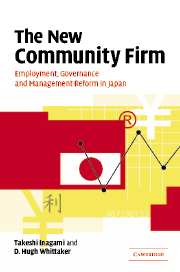14 - New Model in the Making?
Published online by Cambridge University Press: 22 September 2009
Summary
In Part 3 we seek, first of all, to link the conclusions of Parts 1 and 2, to discuss change and continuity in the community firm, and prospects for its future. We begin with a brief reflection on the rise of the classic model and its association with producer-oriented industrial capitalism, and the problems encountered by both, which led to concerted efforts at reform in the late 1990s. The result, as we saw in Parts 1 and 2 was not fundamental discontinuity; the community firm has survived, but it has changed in several crucial respects.
If we conceive of the changes as movement along a continuum between a community pole and a market pole, most firms find themselves somewhere in between, but nearer to the community pole than the market one. This is not necessarily an unstable position to be in, as firms have good reasons to try to balance market forces with community dynamics, and vice versa. We explore this middle ground to better understand the nature of what we will call the ‘reformed model’.
In section three we examine marketization's companion, financialization (Dore, 2000), and whether shareholders will bring fundamental change where product markets and internal reform have not. Japan's financial sector has been in crisis, and is undergoing great changes, but these, we argue, will not necessarily mirror those in the USA and UK in the 1980s and 1990s. Japan's future does not necessarily lie in financial capitalism.
- Type
- Chapter
- Information
- The New Community FirmEmployment, Governance and Management Reform in Japan, pp. 237 - 254Publisher: Cambridge University PressPrint publication year: 2005



